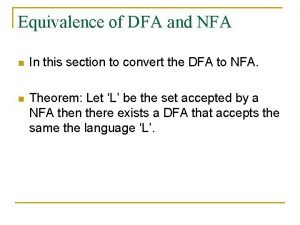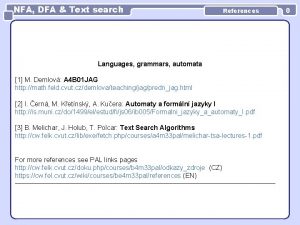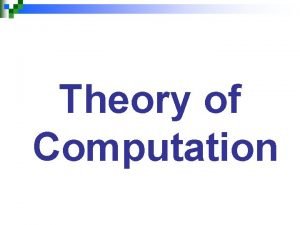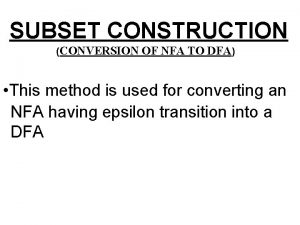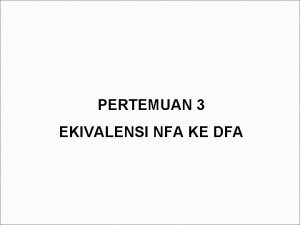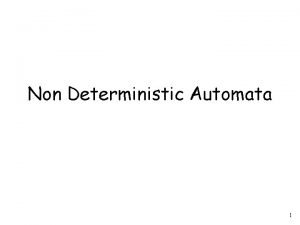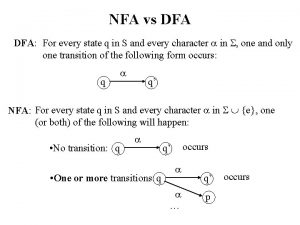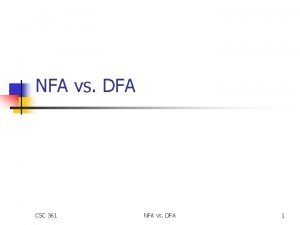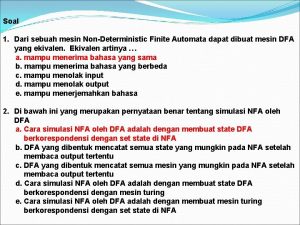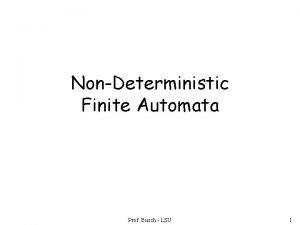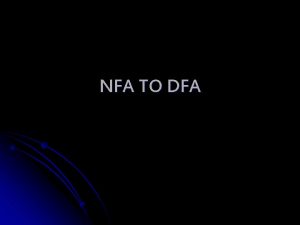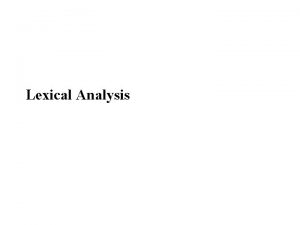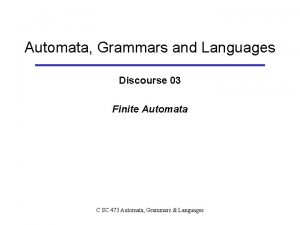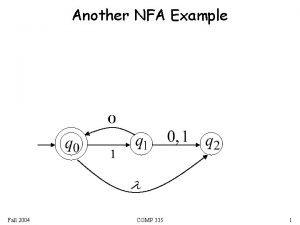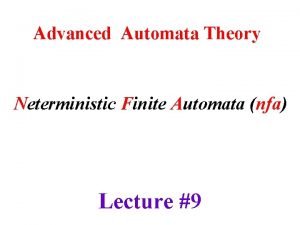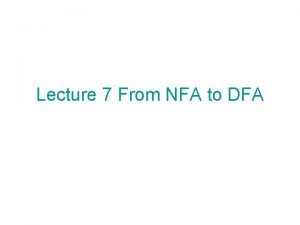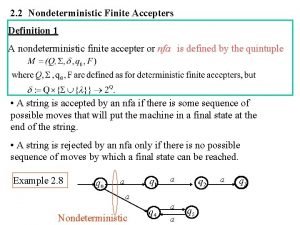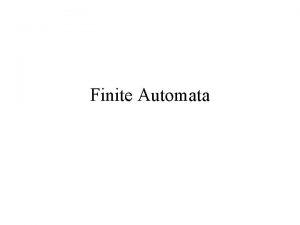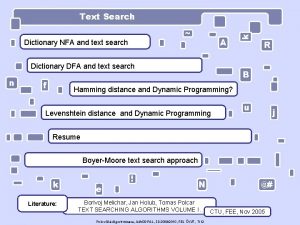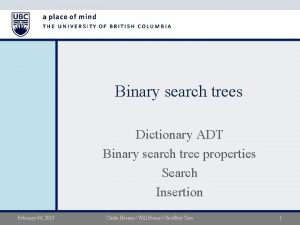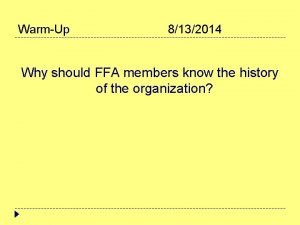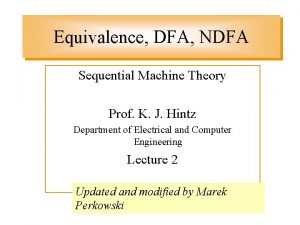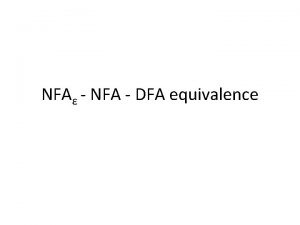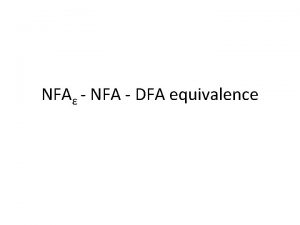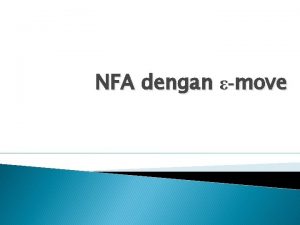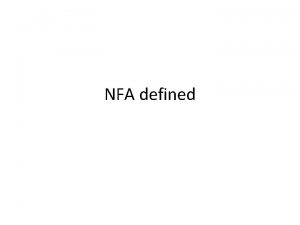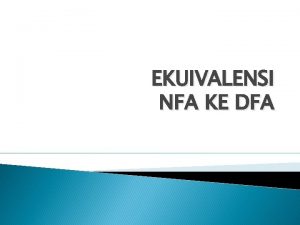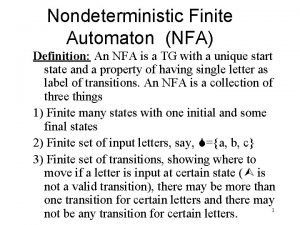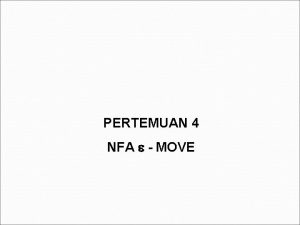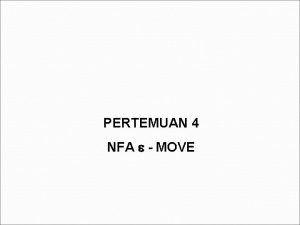Dictionary NFA and text search A Dictionary DFA





























- Slides: 29

~ Dictionary NFA and text search A Dictionary DFA and text search n f k Text Search R B Hamming distance and Dynamic Programming? Levenshtein distance and Dynamic Programming u j Resume Boyer-Moore text search approach k Literature: e ! N Borivoj Melichar, Jan Holub, Tomas Polcar TEXT SEARCHING ALGORITHMS VOLUME I. Pokročilá Algoritmizace, A 4 M 33 PAL, ZS 2009/2010, FEL ČVUT, 7/12 @# CTU, FEE, Nov 2005

Finite language Is a dictionary Dictionary over an alphabet A is a finite set of strings (patterns) from A*. Dictionary automaton searches the text for any pattern in the given dictionary. Recycle older knowledge 1. Dictionary is a finite language. 2. Each finite language is a regular language. 3. Each regular language can be described by a regular expression. 4. Any language described by a regular expression can be searched for in any text using appropriate NFA/DFA. Example Alphabet A = {a, c, d, e, g, h, i, l, m, n, o, q, r, s, t, u, v, y} Dictionary D = {"add", "advanced", "algorithms", "to", "your", "algonqiuan", "adventures"} The Algonquian are one of the most populous and widespread North American native language groups. 1

Finite language Building Automaton Merge repeatedly into a single state any two states A and B such that path from S to A and from S to B are of equal length and contain equal sequence of transition labels. You may find e. g. BFS/DFS to be useful. S a d d a d v a n c e d a l g o r i t h m s t o y o u r a l g o n g u i a n a d v e n t u r e s 2

Finite language a S Building Automaton d d d v a n c e d l g o r i t h m s l g o n g u i a n d v e n t u r e s u r t o y o 3

Finite language Building Automaton d d a S l t o y o v a n c e d v e n t u r e s g o r i t h m s g o n g u i a n u r 4

Finite language Building Automaton d d v a S l t o y o g u a n c e d e n t u r e s o r i t h m s o n g u i a n r 5

Finite language Building Automaton d d v a S l t o y o g u a n c e d e n t u r e s o r i t h m s n g u i a n r 6

Dictionary NFA 7 Automaton Search NFA for dictionary D = {"add", "advanced", "algorithms", "to", "your", "algonqiuan", "adventures"} 3 d A 1 2 v 4 a d n 6 c 7 e 8 d 9 e 1 a 5 10 l 0 17 g 18 o 19 n r 11 20 t i 12 21 u t 13 22 r h 14 23 e m 15 24 s s 16 25 n 26 t y 32 34 o o 33 35 u 36 r 37 q 27 u 28 i 29 a 30 n 31

Small Optimization d v In Fact Unecessary a a n c e d Optionally, identical suffixes can be merged too, but it is not necessary as effectivity will be granted on the next slide. SS Anyway, be careful. SS t y o u r This is a wrong construction. It would incorrectly add word "tour" to the dictionary. 8

Dictionary DFA Favourably Sized The transition diagram of a dictionary NFA, like A 1 in the previous example, is a directed tree with the start state in the root. The only loop is the self-loop in the start state labeled by the whole alpahbet. This NFA has an usefull property: Effectivity Transforming dictionary NFA of this shape to DFA does not increase the number of states. Example The transition diagram of the resulting DFA has 38 states (same as NFA) and 684 transitions. It would not fit nicely into one slide, therefore we present only the transition table. . . : Homework: Draw it! 9

Dictionary DFA 10 Example Part 1 a c d e g h i l m n o q r s t u v y 0 0, 1 0 0 0 0, 32 0 0 0, 34 0, 1 0 0, 2 0 0 0, 17 0 0 0 0, 32 0 0 0, 34 0, 32 0, 1 0 0 0 0 0, 33 0 0, 32 0 0 0, 34 0, 1 0 0 0 0 0, 35 0 0 0, 32 0 0 0, 34 0, 2 0, 1 0 0, 3 0 0 0, 32 0 0, 17 0, 1 0 0 0 0, 32 0 0 0, 34 0, 33 0, 1 0 0 0 0, 32 0 0 0, 34 0, 35 0, 1 0 0 0 0, 32 0, 36 0 0, 34 0, 3 0 0 0 0, 32 0 0 0, 34 0, 1, 5 0 0 0 0, 32 0 0 0, 34 0, 18 0, 1 0 0 0 0 0, 19 0 0, 32 0 0 0, 34 0, 36 0, 1 0 0 0, 37 0 0, 32 0 0 0, 34 0, 1, 5 0, 1 0 0 0, 2 0 0, 17 0 0, 6 0 0 0, 32 0 0 0, 34 0, 1 Transition table of DFA A 2 equivalent to dictionary NFA A 1. 0, 4 0, 34 Continue. . . F F

Dictionary DFA 11 Example Part 2 . . . continued a c d e g h i l m n o q r s t u v y 0, 10 0, 1 0 0 0 0 0, 11 0 0 0, 32 0 0 0, 34 0, 19 0, 1 0 0 0 0 0, 26 0 0 0, 20 0 0, 32 0 0 0, 34 0, 37 0, 1 0 0 0 0, 32 0 0 0, 34 0, 7 0 0 0 0, 32 0 0 0, 34 0, 11 0, 1 0 0 0 0, 12, 32 0 0 0, 34 0, 26 0, 1 0 0 0, 27 0 0 0, 32 0 0 0, 34 0, 20 0, 1 0 0 0, 21 0 0 0 0, 32 0 0 0, 34 0, 7 0, 1 0 0 0, 8 0 0 0, 32 0 0 0, 34 0, 12, 0, 1 32 0 0 0 0 0, 33 0 0, 32 0, 13 0 0, 34 0, 27 0, 1 0 0 0 0, 32 0, 28 0 0, 34 0, 21 0, 1 0 0 0 0, 22, 32 0 0 0, 34 0, 8 0, 1 0 0, 9 0 0 0, 32 0 0 0, 34 0, 13 0, 1 0 0 0, 14 0 0, 32 0 0, 6 0, 1 0 0, 34 continue. . . F

Dictionary DFA 12 Example Part 3 . . . continued a c d e g h i l m n o q r s t u v y 0, 28 0, 1 0 0 0, 29 0 0 0 0, 32 0 0 0, 34 0, 22, 0, 1 32 0 0 0, 23 0 0 0, 33 0 0, 32 0 0 0, 34 0, 1 0 0 0 0, 32 0 0 0, 34 0, 1 0 0 0, 15 0 0 0, 32 0 0 0, 34 0, 23 0, 1 0 0 0 0, 24 0 0 0, 32 0 0 0, 34 0, 1, 30 0 0 0, 32 0 0 0, 34 0, 15 0, 1 0 0 0 0, 16 0, 32 0 0 0, 34 0, 24 0, 1 0 0 0 0, 25 0, 32 0 0 0, 34 0, 1, 0, 1 30 0 0, 2 0 0 0, 17 0 0, 31 0 0 0, 32 0 0 0, 34 0, 16 0, 1 0 0 0 0, 32 0 0 0, 34 F 0, 25 0, 1 0 0 0 0, 32 0 0 0, 34 F 0, 31 0, 1 0 0 0 0, 32 0 0 0, 34 F 0, 9 0, 29 . . . finished. F

Dictionary DFA Tiny Example of dictionary automaton which transition diagram fits to one slide. NFA Alphabet = {a, b} Dictionary = {"aba", "aab", "bab"} 13

Dictionary DFA Tiny Example Alphabet = {a, b} Dictionary = {"aba", "aab", "bab"} 14

Hamming Distance DP Approach DP approach to text search considering Hamming distance Alphabet {a, b, c, d}, pattern P: adbbca, text T: adcabcaabadbbca. For each alignment P with T determine Hamming distance between P and t[k-m+1], t[k-m+2]. . . , t[k] T: P: t[1] . . . t[k-m+1] p[1] . . . t[k-1] t[k] p[m-1] p[m] . . . t[n] Method Let pattern P be p[1], p[2], . . . , p[m], let text T be t[1], t[2], . . . , t[n]. Create dynamic programming table D[m+1][n+1], which elements d[i][k] are defined as follows: 1. d[0][k] = 0 // for k = 0, . . . , n 2. if (p[i] == t[k]) d[i][k] = d[i-1][k-1] else d[i][k] = d[i-1][k-1] +1 // for 1 ≤ i ≤ k, i ≤ m, k ≤ n, Fill the table row by row. Element d[m][k] holds the Hamming distance of P from the substring t[k-m+1], t[k-m+2]. . . , t[k]. 15

Hamming Distance DP Approach? Alphabet {a, b, c, d}, pattern P: adbbca, text T: adcabcaabadbbca. D - a d c a b c a a b a d b b c a - 0 0 0 0 a - 0 1 1 0 0 1 1 1 1 0 d - - 0 2 2 1 1 2 0 2 2 b - - - 1 3 2 2 3 3 1 2 3 0 2 3 3 b - - 2 3 3 3 4 3 2 3 3 0 3 4 c - - - 3 3 4 4 5 4 3 4 4 0 4 a - - - - 3 4 5 5 5 4 5 5 0 Highligted cells represent a match between the text and the pattern. Though it looks scientifically advanced, it is, in fact, only a basic naive approach : -). Each diagonal corresponds to some alignment of pattern with text where mismatches in this alignment are counted one by one. 16

Levenshtein Distance DP Approach DP approach to text search considering Levenshtein distance Let pattern P be p[1], p[2], . . . , p[m], let text T be t[1], t[2], . . . , t[n]. Create dynamic programming table D[m+1][n+1], which elements d[i][k] are defined as follows: 1. d[i][0] = i; d[0][k] = 0, for i = 0, . . . , m, k = 1, . . . , n 2. // d[i][k] is computed using the information about // the minimum possible number of applications of operations // delete, insert, rewrite to the strings shorter by one last character // and followed by at most one edit operation for 1 ≤ i ≤ m, 1 ≤ k ≤ n: d[i][k] = minimum of ( d[i-1][k] +1, // delete p[i] if( i < m ) d[i][k-1] + 1, // insert after p[i] d[i-1][k-1] + (p[i] == t[k]) ? 0 : 1 ) // leave or rewrite p[i] Fill the table row by row. The cell d[m][k] contains the minimum Levenshtein distance of P from the substring Sx, k = t[x], t[x+1], . . . , t[k], where x { k-m+1 -d[m][k], . . . , k-m+1+d[m][k] } and the particular value of x is not known. 17

Levenshtein Distance DP Approach Alphabet {a, b, c, d}, pattern P: adbbca, text T: adcabcaabadbbca. D - a d c a b c a a b a d b b c a - 0 0 0 0 a 1 0 1 1 0 0 1 1 1 1 0 d 2 1 0 1 1 1 2 1 1 0 1 2 2 1 b 3 2 1 1 2 2 2 1 0 1 2 2 b 4 3 2 2 2 3 3 2 2 2 1 0 1 2 c 5 4 3 2 3 4 3 3 3 2 1 0 1 a 6 5 4 3 2 3 4 3 2 1 0 Highligted cells represent a match between the text and the pattern. d[i][k] = minimum of ( d[i-1][k] +1, if( i < m ) d[i][k-1] + 1, d[i-1][k-1] + (p[i] == t[k]) ? 0 : 1 ) // delete p[i] // insert after p[i] // leave or rewrite p[i] 18

Levenshtein distance Recall Dist("BETELGEUSE", "BRUXELLES") = 6 B R U X E L L E S 0 1 2 3 4 5 6 7 8 9 B 1 0 1 2 3 4 5 6 7 8 E 2 1 1 2 3 3 4 5 6 7 T 3 2 2 2 3 4 4 5 6 7 E 4 3 3 3 4 5 5 6 L 5 4 4 4 3 4 5 6 G 6 5 5 5 4 4 5 6 E 7 6 6 5 5 5 4 5 U 8 7 7 6 6 6 5 5 S E 9 10 8 9 7 8 7 7 7 8 6 7 5 6 19

Levenshtein distance Recall and Compare Levenshtein distance of strings Dist(A, B) = |m ─ n| Old stuff Dist(A, B) = 1+ min ( Dist(A[1. . n ─ 1], B[1. . m]), Dist(A[1. . n], B[1. . m ─1]), Dist(A[1. . n ─1], B[1. . m ─1]) ) Dist(A, B) = Dist(A[1. . n ─ 1], B[1. . m─1]]) Calculation corresponds to 1+ Dist(A[1. . n ─1], B[1. . m]), 1+ Dist(A[1. . n], B[1. . m ─1]), 1+ Dist(A[1. . n ─1], B[1. . m ─1]) . . . 20 if n = 0 or m = 0 if n > 0 and m > 0 and A[n] ≠ B[m] if n > 0 and m > 0 and A[n] = B[m] Operation Insert(A, n ─1, B[m]) or Delete(B, m) Insert(B, m ─1, A[n]) or Delete(A, n) Rewrite(A, n, B[m]) or Rewrite(B, m, A[n]) Text search considering Levenshtein distance New stuff d[i][k] = minimum of ( d[i─1][k] +1, // Delete p[i] if (i < m) d[i][k─1] +1, // Insert after p[i] d[i─1][k─1] + (p[i] == t[k])? 0: 1) ) // leave or Rewrite p[i]

Levenshtein Distance DP Approach D - a d c a b c a a b a d b b c a - 0 0 0 0 a 1 0 1 1 0 0 1 1 1 1 0 d 2 1 0 1 1 1 2 1 1 0 1 2 2 1 b 3 2 1 1 2 2 2 1 0 1 2 2 b 4 3 2 2 2 3 3 2 2 2 1 0 1 2 c 5 4 3 2 3 4 3 3 3 2 1 0 1 a 6 5 4 3 2 3 4 3 2 1 0 Challenge Value d[m][k] registers only the distance of a substring S in the text which end is aligned with P and it is the minimum distance of all such substrings. There is no reference in the DP table to the actual length S i. e. to its start position. To find string S = Sx = t[x], t[x+1]. . . , t[k], where x {k─m+1─d[m][k], . . . , k─m+1+d[m][k] } we must consider all values of x and compute Levenshtein distance (Sx, P) for each x separately and choose x which attains minimum. 21

Text Search Using Automata Summary Text search using finite automata brings in many possibilities regarding what can be effectively found: A. Any given exact pattern P. (e. g. ababccabc) B. Any word of any language specified by a particular DFA or NFA. (Just add the loop labeled by the whole alphabet to the start state. ) C. Any string which represents some modification of the pattern P: A string within (or exactly at) a given Hamming distance from P A string within (or exactly at) a given Levenshtein/edit distance from P. D. Any of strings in a given (finite) dictionary. E. Any word of any language described by a regular expression. F. Any union, intersection, concatenation, iteration of any of cases A. - F. G. Any string containing any of cases A. - F. as a subsequence. (Just add the loops labeled by the whole alphabet to all states. ) 22

Text Search Boyer-Moore The idea: Align the pattern with the text and start matching backwards from the end of the pattern. When a mismatch occurs there is a chance that the pattern may be shifted forward by many positions and sometimes by the whole pattern length. Ideal case mismatch Text x Pattern y Shift after mismatch Pattern does not contain symbol x. y The longer is the pattern the more effective is the search. (The bigger the data the faster the algorithm, quite an unusual situation. . . ) Pokročilá Algoritmizace, A 4 M 33 PAL, ZS 2009/2010, FEL ČVUT, 7/12 23

Text Search Boyer-Moore Mismatch at the last position of the pattern. Bad Character Shift table (BCS) When the last symbol of pattern (y) is mismatched with symbol x in the text shift the pattern to the right to match the first occurrence (from the end) of x in the pattern with x in the text. When the pattern does not contain x shift it by its whole length. BCS is indexed by all symbols of alphabet. For each symbol in the pattern it contains the symbol’s minimum distance from the end of the pattern. If the symbol is not in the pattern the table entry is equal to the pattern length. Example Mismatch x Text Pattern x Shift after mismatch y x x x y Text BCCFABBEC Pattern FABBE BCS ABCDE F 3 1 5 5 0 4 24

Text Search Boyer-Moore Mismatch after partial match at the end of the pattern. When a suffix S of the pattern matches the text and the symbol x immediately Preceding S mismatches the text then there are three cases: 1. The suffix S occurs more times in the pattern and the other occurrence is not immediately preceded by x. In this case, shift the pattern so that the nearest described instance of S matches the text again at the same position. That is, shift the pattern by the distance between these occurrences of suffix S. Example Mismatch b x y z Text Pattern c x y z a x y z c x y z Shift after mismatch a x y z Here could be e. g. b ! No need to try to match a another time a x y z 25

Text Search Boyer-Moore 2. There is a suffix W which length does not exceed the length of S and W is also A prefix of the pattern. Take the longest possible W and denote its occurrence at the beginning of the pattern by Q. Then shift the pattern by the distance between Q and W. Example b z x y Text Pattern x y b f l m Shift after mismatch a z x y x y b f l m a z x y Longest suffix after mismatch which is also a prefix 3. Neither case 1. nor case 2. happens. Then shift the pattern by its whole length. Example is unnecessary 26

Text Search 27 Boyer-Moore The shift can be calculated for all three cases : Take suffix S as a separate string and align it with its original position in the pattern. Then keep shifting S to to the left until one of the cases 1. , 2. , 3. is detected (at least 3. must happen after some time). Register the distance between the current and the original position of S. Good Suffix Shift (GS) table contains the shift values for all suffixes S. Example Pattern ADBACBACBA Pattern length: 10 Positions indexed from 1, 0 represents shift after complete match. Apply case 2. after complete match GS position mismatches 9 B 8 C 7 A 6 B 5 C 4 A 3 B 2 D 1 A 0 - suffix A BA CBA ACBA BACBA CBACBACBA BACBACBA DBACBACBA ADBACBACBA shift 9 6 9 9 3 9 9 9 10 9

Text Search Boyer-Moore 28 Example Pattern BCS POVA LOVAL _ AEK LNOPS T V 9 1 9 9 4 9 3 8 9 9 2 GS 0 1 2 3 4 5 6 7 8 9 9 9 4 9 9 9 POVA LOVAL GS[5] == 4 GS[6] == 9 Search progress BCS[P] == 8 Text ON _ SE _ V _ PAL _ POVAL _ A _ NEKVAL TOVAL POVA LOVAL POVALOVAL POVA LOVAL
 Equivalence of nfa and dfa
Equivalence of nfa and dfa Dfa and nfa
Dfa and nfa Nfa theory of computation
Nfa theory of computation Subset construction method refers to:
Subset construction method refers to: Dari sebuah mesin nfa dapat dibuat mesin dfa yang
Dari sebuah mesin nfa dapat dibuat mesin dfa yang Dfa to nfa
Dfa to nfa Nfa dfa
Nfa dfa Dfa vs ndfa
Dfa vs ndfa Ekuivalen nfa ke dfa
Ekuivalen nfa ke dfa Dari sebuah mesin nfa dapat dibuat mesin dfa yang
Dari sebuah mesin nfa dapat dibuat mesin dfa yang Unit 2
Unit 2 E-move
E-move Convert nfa to dfa
Convert nfa to dfa Nfa to dfa subset construction method
Nfa to dfa subset construction method Convert nfa to dfa
Convert nfa to dfa Nfa to dfa conversion solved examples
Nfa to dfa conversion solved examples Convert nfa to dfa
Convert nfa to dfa Recursive definition of nfa
Recursive definition of nfa Convert the following nfa to dfa:(upload)
Convert the following nfa to dfa:(upload) Accepters
Accepters Automata
Automata Nfa search
Nfa search What is an example of a text-to-media connection?
What is an example of a text-to-media connection? Dictionary binary search tree
Dictionary binary search tree Informed search and uninformed search
Informed search and uninformed search National ffa alumni association was formed
National ffa alumni association was formed Equivalence of dfa and ndfa
Equivalence of dfa and ndfa Time and space complexity of uninformed search
Time and space complexity of uninformed search Federated search vs discovery
Federated search vs discovery èinterest
èinterest
